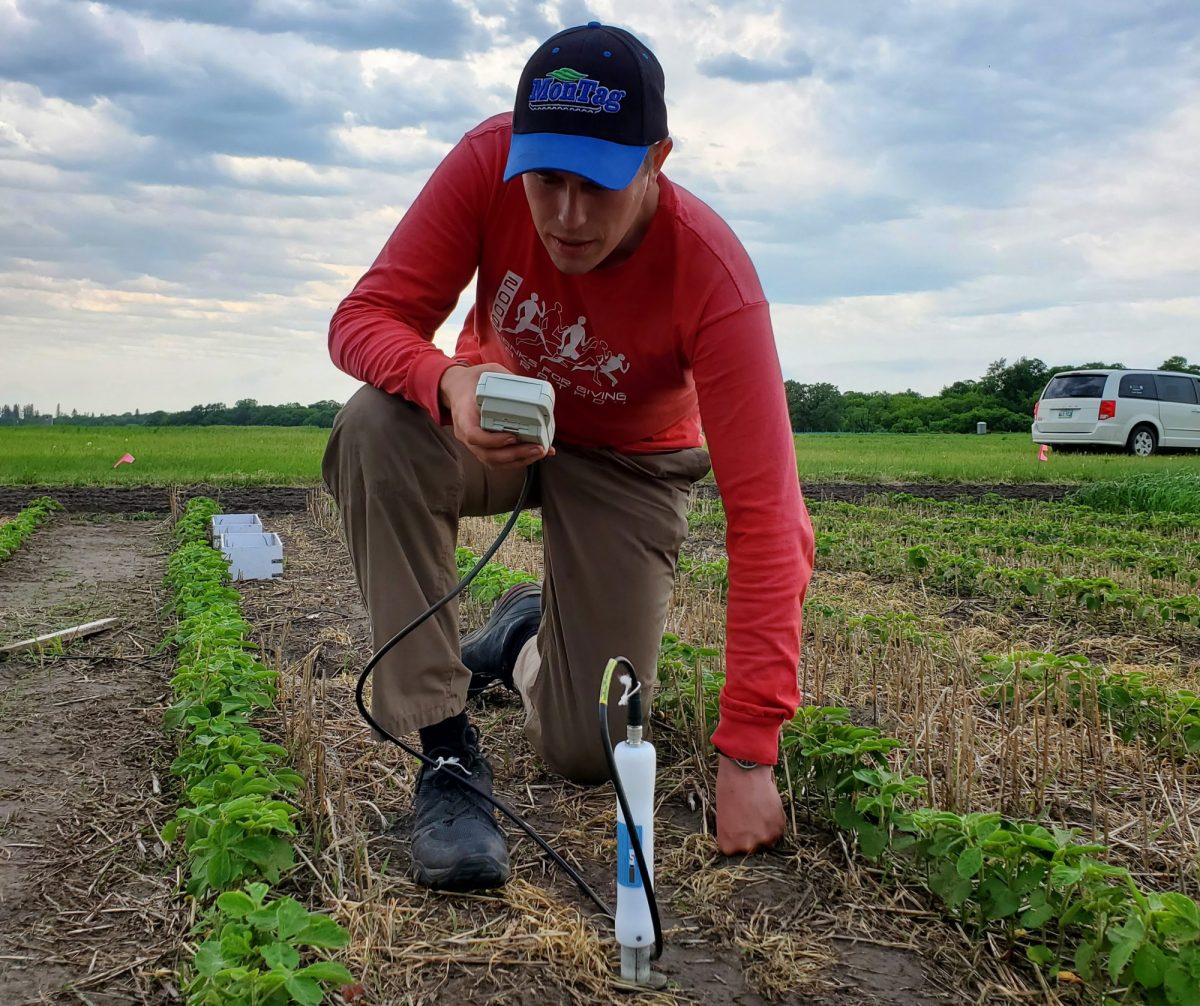
Callum Morrison takes moisture readings in soybean cash crop in long-term cover cropping field trial in Carman, MB.
Cover crop survey seeks prairie farmer input
PhD student Callum Morrison and supervisor Yvonne Lawley in the Department of Plant Science are surveying prairie farmers to determine their interest and experiences with growing cover crops. The research is one part of a larger multi-year study into cover cropping at the University of Manitoba under Dr. Lawley.
WHAT ARE COVER CROPS?
Cover crops are grown when a cash crop is not growing, such as after harvest. The primary aim of cover crops is to benefit the soil, and improve subsequent crops, however cover crops can also be grown to for a number of reasons including weed control and to increase biodiversity.
A common example would be planting a fall rye cover crop following harvest of a cereal grain crop. These types of “fall shoulder” season cover crops will grow through the fall until freeze up. If the cover crop can overwinter, they will also grow next spring until they are terminated using herbicides or tillage before planting next year’s crop.
Full season cover crops have also being used to tackle problem soils, and may involve a farmer taking an entire field or targeted areas within a field out of annual cash crop production to improve the soil. Farmers with fields that were too wet for planting may plant a cover crop to dry out a field and improve the soil for planting the following year. Full season cover crops are popular with cattle producers as they can be grazed at the end of the season.
A NEED FOR MORE INFORMATION
There had been no recent studies to investigate how or why cover crops are being used by early adopter farmers across the Prairies. Many of these early adopters have questions they would like to see addressed through research and extension.
As a result, the Prairie Cover Crop Survey has been developed by Lawley and her team to address these gaps in knowledge. It is also intended to provide information through annual reports to interested farmers, agronomists, researchers, policy makers, and government organizations. These reports can be used as part of farmers’ decision-making process by allowing them to see how cover crops are being adopted by farmers like them. The survey also gives respondents a voice to highlight areas for future research.
The survey’s first year results included 211 producers accounting for about 83,500 acres of cover crops across the Prairies. Cover crops were found to have been grown as far north as the Peace River Valley in North Western Alberta, all the way down to the US border.
Morrison hopes he can expand on the number of respondents for the 2020 survey.
“So far this year we have 150 respondents, which is very encouraging. It is my hope that we will receive responses from as many farmers as possible.”
Farmers of all types are called upon to take part in the 15 minute survey – whether they have grown a cover crop or not. See the survey details and link below.
Learn more about the Cover Crop Survey by reading Dr. Lawley’s article “Cover crop research across the Prairies” in Better Farming Prairies (February 2020).
Welcome to the 2020 Prairie Cover Crop Survey
This survey is intended for farmers in the Canadian Prairie Provinces of Manitoba, Saskatchewan and Alberta. It is intended to be taken by one person per farm. We welcome the participation of farmers that are currently growing cover crops, have grown them in the past, or are still just thinking about growing cover crops for the 2020 survey. If you participated in the 2019 cover crop survey, we encourage you to add your voice to the 2020 survey.
The survey will take around 15 – 20 minutes depending on the participant.
Your personal information will not be disclosed in the survey report. Information will be aggregated by province, municipality, commodity, and farm type.
Results will be made available to participants annually if you choose to provide your contact information.
Thank you for taking the time to add your voice to this survey! Your participation in our cover crop research project is appreciated and will benefit growers and those thinking of cover crops alike.






